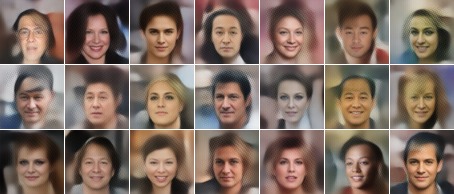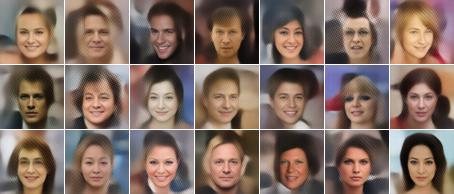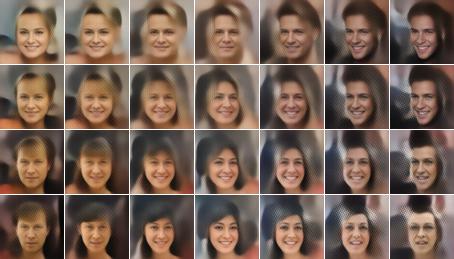Utilities for exploring generative latent spaces as described in the Sampling Generative Networks paper.
Install this library, code supporting a model type, and go.
$ pip install plat
$ pip install git+https://github.com/dribnet/discgen.git \
-r https://raw.githubusercontent.com/dribnet/discgen/master/requirements.txt
$ plat sample --model celeba_64.discgen
Model celeba_64.discgen will be downloaded. Continue? [Y/n] y
Saving image file plat_20161006_celeba_64_discgen_01.png
By default, plat does a random sampling. The output file will be automatically generated, or can be given explicitly. To make the results repeatable, you can also specify a random seed.
$ plat sample \
--model celeba_64.discgen \
--seed 1 \
--outfile examples/random_sample.jpg
The number of rows and columns can be specified. Interpolation is done by specifying the spacing between samples.
$ plat sample \
--model celeba_64.discgen \
--seed 1 \
--rows 1 --cols 7 \
--spacing 6 \
--outfile examples/random_interpolation.jpg
Interpolation can be done across multiple points in two dimensions to create a mine grid (details in paper).
$ plat sample \
--model celeba_64.discgen \
--seed 1 \
--rows 3 --cols 7 \
--spacing 3 \
--outfile examples/random_mine_grid.jpg
There are many more options to explore. When experimenting, it can be useful to use a templated output filename.
$ plat sample \
--model celeba_64.discgen \
--seed 17 \
--tight \
--rows 3 --cols 7 \
--spacing 2 \
--outfile examples/%DATE%_experiment_s%SEED%_%SEQ%.jpg
plat comes with access to a growing list of models and model types in its model zoo. Each model type will have separate dependencies.
It's also possible to run plat on new types of models by providing a simple plat interface.
There are a few examples and a template
to get started. Here's an example of how to use plat sample with a manually specified
model interface to generate a (random) mine grid from an iGAN model:
PYTHONPATH=. plat sample \
--model-interface plat.interface.igan.IganModel \
--model-file models/shoes_64.dcgan_theano \
--uniform \
--rows 4 --cols 10 \
--tight --spacing 3 \
--image-size 64 \
--seed 1




